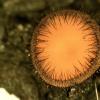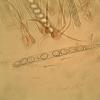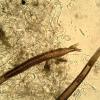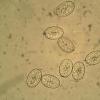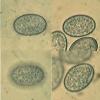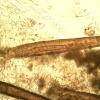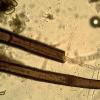
02-01-2026 17:43
MARICEL PATINOHi there, although I couldn't see the fruitbody, I

04-01-2026 17:45
 Stephen Martin Mifsud
Stephen Martin Mifsud
I was happy to find these orange asmocyetes which

03-01-2026 13:08
Niek SchrierHi all,We found groups of perithecia on a Lecanora

29-12-2025 17:44
Isabelle CharissouBonjour,J'aimerais savoir si d'autres personnes au

01-01-2026 18:35
Original loamy soil aside a artificial lake.The co

31-12-2025 19:27
Collected from loamy soil, at waterside (completel
Scutellinia
Malcolm Greaves,
21-05-2013 18:55
The spores averaged 18.5 x 12.3 and had small sometimes interconecting warts.
There were three distinct types of hair, firstly long 1200um then short 250 -400 and finally very short and rounded.
This lead me to S critina but the unusual find was that some of the small hairs were growing inside the longer ones. On checking Schumacher it is apparently not unusual and cannot be used in helping to identifying to species but it is the first time I have seen it.
Mal
Michel Delpont,
21-05-2013 20:14

Re : Scutellinia
Good evening Malcolm
Your fungus also makes me think S.crinita I harvested a few days ago. Beautiful species with the long hair.
Michel.
Your fungus also makes me think S.crinita I harvested a few days ago. Beautiful species with the long hair.
Michel.
Beñat Jeannerot,
21-05-2013 21:03

Re : Scutellinia
Dear Malcolm,
S. crinita.
About hairs inside others, it's a very common fact in this genus. Not a discriminate factor.
Regards,
Beñat
S. crinita.
About hairs inside others, it's a very common fact in this genus. Not a discriminate factor.
Regards,
Beñat



